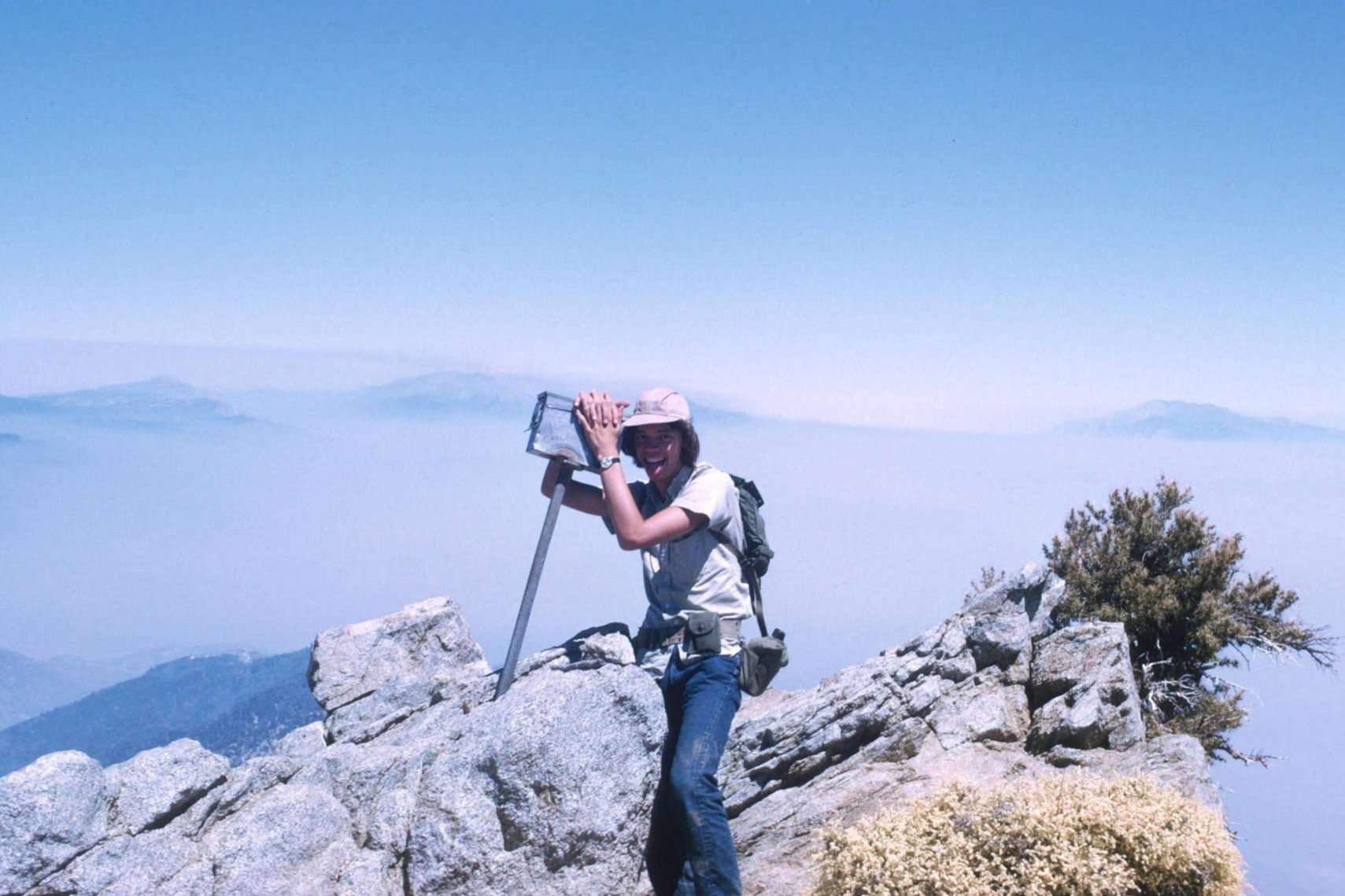About
I grew up in Southern California, which provided many early opportunities for studies in sedimentology and coastal processes. I knew by third grade that I wanted to be a teacher and scientist.
Geology in a bucket at Redondo Pier
At Upland High School, I split time between academic pursuits and the track team. Honors English classes were outstanding and I got lots of experience writing with teachers Cal French and Alan Rhodes, but my first love was chemistry, taught by Ken Johnson, who had an M.S. in geology.
Running the 180-yard low hurdles.
One of my teammates was a correspondent for a local afternoon newspaper, and I apprenticed with him and wrote my first story for the paper at age 15. I learned to collect and tabulate all the game statistics, write stories in my head, and type them out in one draft on a manual typewriter late at night in the sports room, under deadline, in a miasma of cigarette smoke and newspaper ink fumes.
Ten bucks worth of sports reporting, times 30, equalled a 1960 VW Beetle with a fabric sunroof and a speedometer (but no gas gauge).
On Cucamonga Peak in 1971, with friend and future geologist Allen Stork, above really, really soupy smog.
I matriculated at Pomona College (go Sagehens!), a last-minute change from UC Riverside that involved selling the aforementioned VW (long story). I decided on the first day of classes to major in geology, a discipline that combines my love of chemistry with my love of the mountains and desert. At Pomona I also: 1. learned that being on the Sagehen track team and passing German were not compatible; 2. had many fun summer jobs including planting geophones and surveying creep along the San Andreas fault, and 3. met my future spouse, Mary Olney.
There are few summer jobs more fun than going to Michigan in 1974 to slog through mud while wiring dynamite and blasting caps together, and then drilling holes and shoving the dynamite down into them. I read Principles of Physical Geology by Arthur Holmes and Atlas Shrugged by Ayn Rand that summer. Guess which stuck.
Arthur Holmes (left) invented U-Pb dating for his undergraduate thesis project and later proposed mantle convection as the underlying cause of continental drift. His student Donald McIntyre (right) was my undergraduate mentor at Pomona College, and thus Holmes is my academic grandfather. McIntyre’s classes were glorious counterexamples to the belief that a good class needs a good syllabus. He came in and talked about whatever was interesting that day—commonly something about plate tectonics that he’d read in the latest issue of Nature.
Plate tectonics was only just gaining acceptance in the early 1970s, and I undertook a study of volcanic rocks in the Mojave Desert and their possible subduction origin for my senior thesis. After graduating from Pomona in 1976 I began graduate studies at UCLA and continued to work on magmatism and plate tectonics for my dissertation. UCLA was a great place to be then, full of brilliant graduate students and faculty and with abundant field trip opportunities and geochemical facilities. I earned a Ph.D. in 1981 and started a faculty position at the University of North Carolina at Chapel Hill that summer.
With teaching responsibilities in petrology, field classes, and introductory geology, I was promoted to Associate Professor in 1988 and full Professor in 1993. I served as Department Chair from 2008-2013 and was appointed the Mary Lily Kenan Flagler Bingham Distinguished Chair in Geology in 2009.
After backpacking field work around Taboose Pass in 1993, Tom Frost of the USGS and I hired a plane to get an aerial view of the High Sierra. That convinced me to get a pilot’s license. I soloed in June of 1994, earned my private pilot license later that year, and earned an instrument rating in 1997 after many enjoyable and challenging hours of instruction by Jim Yankaskas. Flying mostly Cessna 152s and Piper Cherokee Warriors, my favorite route was a loop from Bishop to Furnace Creek, Lone Pine, and back to Bishop with friend Scott Hetzler. We intended to, but never did, play 9 holes of golf at each of those locations during such a trip.
Lined up on final approach in a Warrior at Sanford (TTA)
I retired in 2019 to devote more time to field work, writing, and traveling. Along with continuing research, I now work on making geology accessible to the public. I’ve written several Geology Underfoot books about areas in California, and love to give talks on various topics including new views of magmatism and the geology of eastern California, Yosemite, and Death Valley. I serve as an expert on Smithsonian Journeys tours, with recent trips to Patagonia, Australia and New Zealand, Alaska, the northern Rockies, and the Grand Canyon-Bryce-Zion region. Mary and I live in Chapel Hill.
Making a map of the glaciated top surface of the Devils Postpile, near Mammoth Lakes, California, using structure-from-motion.
Glorious scenery along Bishop High Sierra 50K course, May 2010
After raising young children and getting tenure, I took up running again in the 1990s and worked up to road marathons before learning the pleasures of trail ultramarathons and abandoning road races. Running ended with an injury in 2013, and I am now an avid cyclist and the proud owner of two Trek bikes, Violet and Almandine.
High point of the 106-mile Triple Bypass Ride from Evergreen to Vail, Colorado, 21 August 2021.
In alternate universes, I may be a fighter pilot, journalist, or fashion photographer.








